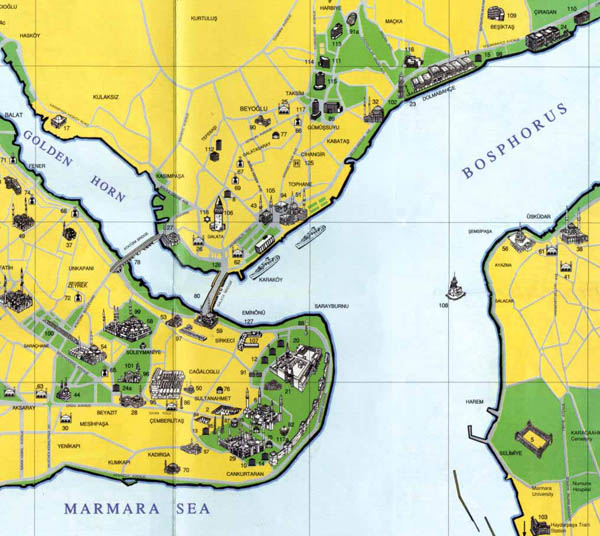by Patrick Weiler
Part 1: Introduction to Istanbul
With around 12 million people, Istanbul is one of the 20 most populous cities in the world (1). Here is a picture from the airplane I flew in on:
You can see that it just goes on and on. And here is another, from a bit closer - looking south, showing the Sea of Marmara to the right, the Golden Horn (Istanbul harbor) near the center and the Bosphorus (the straits between the Sea of Marmara and the Black Sea) stretching horizontally across the center of the photo.
Here is a map showing the main sights of the city (2) with the Swissotel on the hill above the Dolmabahce Palace near the upper right.

The next photo shows the area on the map, but from the other direction, with the hotel to the far left above the Dolmabahce Palace on the waterfront and the Topkapi Saray and Blue Mosque across the Golden Horn in the middle of the picture near the top.
We stayed one pre-conference night in the Sultanahmet area, near the Blue Mosque and Topkapi Saray. It is the old part of the city and there are many carpet stores in the dizzyingly narrow, labyrinthine streets and in the Arasta Bazaar just below the Blue Mosque. Here is a photo of the Arasta Bazaar, with one of Mehmet Cetinkaya’s shops on the right. Cetinkaya was the linchpin of the ICOC, pulling all the pieces together, keeping everyone on task and making it all happen.
The Arasta Bazaar is a long street with dozens of tiny carpet shops on either side and many tourist shops with goods like Iznik-type tiles, handbags (and even shoes) made from old kilims, jewelry shops and everywhere the blue Evil Eye protector (3), in every size and shape imaginable:

See the story of the evil eye in the footnotes below (4). Since this is a rug web site, here is a Baluch(?) rug from the Arasta Bazaar:
The other, even more impressive bazaar in Istanbul is the Grand Bazaar, a 15th century several-square-block covered mall with hundreds of small shops. You could spend days there and not see everything (12). Here is a picture of the Grand Bazaar from the inside:
Many tourists visit the Grand Bazaar, but below the bazaar are streets filled with shops frequented by the locals and farther down, near the waterfront, is the famous Spice Bazaar. This photo of the streets below the Grand Bazaar on the way to the Spice Bazaar was taken mid-day on Thursday:
And here is one of a store in the Spice Bazaar:
Several other things you will find in Turkey, without fail, are the Turkish flag in gargantuan proportions, cigarettes, the call to prayer 5 times a day starting at around 4:30 AM broadcast by loudspeaker from the minarets of the mosques, and pictures of Mustafa Kemal Ataturk, the founder, in 1923, of the modern secular government (secular so far with the occasional help of the military – see recent news articles about rallies to support the secular government). Here is a photo showing a huge portrait of Ataturk hanging from the front of a building on the Bosphorus. I photographed it during the conference cruise:
There was an elegant painting in the lobby of the hotel, which I thought might be of the hotel founder, but upon closer inspection proved to be our friend, Ataturk, in a tuxedo. He modernized the infrastructure and schooling, gave the vote to women and outlawed the veil, changed the alphabet from Arabic to Latin and instituted the secular democracy that someday may help Turkey to become a European Union nation. He required surnames, a Western tradition, and was given the surname Ataturk, or Father of the Turks, by the Turkish Grand Assembly in 1934. Here is one of the innumerable flags, this one hanging from a building on the Bosphorus, also photographed on the ICOC cruise:
Many flags were hung in honor of International Children’s Day, April 23rd, a holiday established by Ataturk. Turkish children take over the office of the president for two hours and send messages of peace to other countries around the world. Turkey is the country of tulips, and they say there were 3 million of them planted in Istanbul this year:
Discussion Home Page Proceed to Part 2